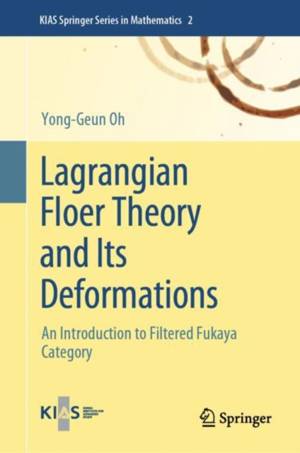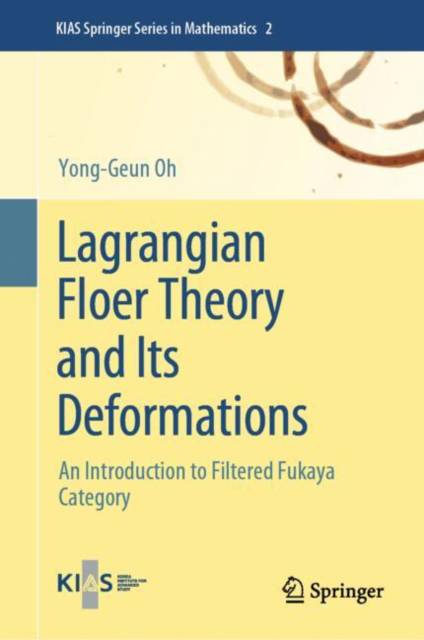
- Retrait gratuit dans votre magasin Club
- 7.000.000 titres dans notre catalogue
- Payer en toute sécurité
- Toujours un magasin près de chez vous
- Retrait gratuit dans votre magasin Club
- 7.000.0000 titres dans notre catalogue
- Payer en toute sécurité
- Toujours un magasin près de chez vous
Lagrangian Floer Theory and Its Deformations
An Introduction to Filtered Fukaya Category
Yong-Geun Oh
152,95 €
+ 305 points
Description
A-infinity structure was introduced by Stasheff in the 1960s in his homotopy characterization of based loop space, which was the culmination of earlier works of Sugawara's homotopy characterization of H-spaces and loop spaces. At the beginning of the 1990s, a similar structure was introduced by Fukaya in his categorification of Floer homology in symplectic topology. This structure plays a fundamental role in the celebrated homological mirror symmetry proposal by Kontsevich and in more recent developments of symplectic topology.
A detailed construction of A-infinity algebra structure attached to a closed Lagrangian submanifold is given in Fukaya, Oh, Ohta, and Ono's two-volume monograph Lagrangian Intersection Floer Theory (AMS-IP series 46 I & II), using the theory of Kuranishi structures-a theory that has been regarded as being not easily accessible to researchers in general. The present lecture note is provided by one of the main contributors to the Lagrangian Floer theory and is intended to provide a quick, reader-friendly explanation of the geometric part of the construction. Discussion of the Kuranishi structures is minimized, with more focus on the calculations and applications emphasizing the relevant homological algebra in the filtered context.
The book starts with a quick explanation of Stasheff polytopes and their two realizations-one by the rooted metric ribbon trees and the other by the genus-zero moduli space of open Riemann surfaces-and an explanation of the A-infinity structure on the motivating example of the based loop space. It then provides a description of the moduli space of genus-zero bordered stable maps and continues with the construction of the (curved) A-infinity structure and its canonical models. Included in the explanation are the (Landau-Ginzburg) potential functions associated with compact Lagrangian submanifolds constructed by Fukaya, Oh, Ohta, and Ono. The book explains calculations of potential functions for toric fibers in detail and reviews several explicit calculations in the literature of potential functions with bulk as well as their applications to problems in symplectic topology via the critical point theory thereof. In the Appendix, the book also provides rapid summaries of various background materials such as the stable map topology, Kuranishi structures, and orbifold Lagrangian Floer theory.
A detailed construction of A-infinity algebra structure attached to a closed Lagrangian submanifold is given in Fukaya, Oh, Ohta, and Ono's two-volume monograph Lagrangian Intersection Floer Theory (AMS-IP series 46 I & II), using the theory of Kuranishi structures-a theory that has been regarded as being not easily accessible to researchers in general. The present lecture note is provided by one of the main contributors to the Lagrangian Floer theory and is intended to provide a quick, reader-friendly explanation of the geometric part of the construction. Discussion of the Kuranishi structures is minimized, with more focus on the calculations and applications emphasizing the relevant homological algebra in the filtered context.
The book starts with a quick explanation of Stasheff polytopes and their two realizations-one by the rooted metric ribbon trees and the other by the genus-zero moduli space of open Riemann surfaces-and an explanation of the A-infinity structure on the motivating example of the based loop space. It then provides a description of the moduli space of genus-zero bordered stable maps and continues with the construction of the (curved) A-infinity structure and its canonical models. Included in the explanation are the (Landau-Ginzburg) potential functions associated with compact Lagrangian submanifolds constructed by Fukaya, Oh, Ohta, and Ono. The book explains calculations of potential functions for toric fibers in detail and reviews several explicit calculations in the literature of potential functions with bulk as well as their applications to problems in symplectic topology via the critical point theory thereof. In the Appendix, the book also provides rapid summaries of various background materials such as the stable map topology, Kuranishi structures, and orbifold Lagrangian Floer theory.
Spécifications
Parties prenantes
- Auteur(s) :
- Editeur:
Contenu
- Nombre de pages :
- 416
- Langue:
- Anglais
- Collection :
- Tome:
- n° 2
Caractéristiques
- EAN:
- 9789819717972
- Date de parution :
- 07-06-24
- Format:
- Livre relié
- Format numérique:
- Genaaid
- Dimensions :
- 156 mm x 234 mm
- Poids :
- 784 g

Les avis
Nous publions uniquement les avis qui respectent les conditions requises. Consultez nos conditions pour les avis.






